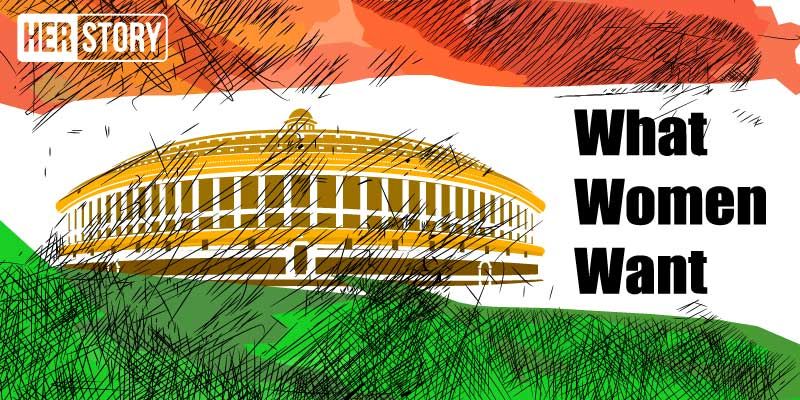Elections 2019: Will the new government keep its promises to the women of India?
The BJP mentioned “women” 37 times in its 48-page election manifesto. Now that Elections 2019 has come to a close, will the new government fulfill all its promises to women when it comes to healthcare, more jobs, participation in government, and more?
Rekha Balakrishnan

Friday May 24, 2019 , 7 min Read
The verdict is clear. The Bharatiya Janata Party (BJP) is back in power for yet another term with Prime Minister Narendra Modi at the helm for the next five years.
As the government is sworn in and the election hoopla of 2019 dies down, it will be time to take stock of the leading party’s promises and how it intends to deliver on them.
HerStory reached out to a cross-section of women across the country to understand what they expect from the new government.
More jobs, better healthcare, women’s safety, increased participation in politics are among the many issues women want to have addressed as the government moves into its second term with a clear mandate.
But before we move onto expectations, it’s imperative we take a look at what the ruling party has done so far for women. What do the numbers indicate, and what more needs to be done in various sectors?

The manifesto released by the ruling BJP just before the elections mentioned the word “women” 37 times in the 48-page document. Does it indicate that women are at the top of the party’s agenda? Let’s break down the promises in the manifesto and understand better what the new term augurs for women in India.
Healthcare
In its previous term, the BJP-led ruling National Democratic Alliance (NDA) government introduced a slew of schemes for women, like the Pradhan Mantri Matru Vandana Yojana, Pradhan Mantri Matritva Suraksha Abhiyan, and Ayushman Bharat, the focus of which all aimed at ensuring good quality, accessible, and affordable maternal healthcare services for all women.
To tackle the issue of malnutrition, the POSHAN Abhiyaan programme has been launched with the aim to bring down malnutrition levels in the country by at least 10 percent in the next five years.
According to the BJP manifesto for 2019, the Mission Indradhanush programme has ensured full immunisation of 3.39 crore children and 87.18 lakh pregnant mothers. The annual increase in the rate of immunisation has jumped from one percent per year to six percent per year. Continuing this pace, the government hopes to full immunisation coverage for all the children and pregnant women by 2022.
Under the Suvidha scheme, efforts were made to ensure women are provided sanitary napkins at an affordable cost of Re 1. However, it is important to remember that the government faced a lot of flak for its Rs 12 tax on sanitary napkins, which was later removed after much lobbying from women and women groups.
The government had also increased the honorarium of ASHA and Anganwadi workers. The manifesto states that the party “will increase the coverage of Ayushman Bharat to include all Anganwadi workers and ASHA workers to ensure improved health and social support system for these frontline workers.”
But clearly more needs to be done when it comes to the health of women, especially in rural areas where there is lack of awareness and access to resources.
Also read: Elections 2019: What women want from the new government
Women in politics
It goes without saying that there needs to be more representation of women in the government. Out of 8,000 candidates, who contested the polls this year, only 700 were women. Only if more women come to the fore will women’s issues like safety be tackled with greater interest and intensity. Let’s talk 33 percent reservation for women in the Parliament again.

Education
The BJP manifesto claims that the gains made under the ‘Beti Bachao, Beti Padhao’ programme have been impressive. The government plans to push this initiative further, and focus on affordable quality education and financial support in the form of loans and subsidies for higher education.
Opportunities and skill development
During the last five years, the NDA government claims to have focussed on ensuring a safe and dignified life for women, providing access to basic resources through various schemes such as Swachh Bharat Abhiyan, Pradhan Mantri Ujjwala Yojana, Pradhan Mantri Awas Yojana, and Saubhagya.
In the next five years to ensure financial empowerment among women in rural and semi-rural areas and create employment opportunities for them, it is hoping to ensure access to credit and other resources, capacity building, market and distribution network for women entrepreneurs, Self-Help Groups (SHGs), and women farmers.
In this regard, the manifesto says, “We are committed to make women equal partners in and equal beneficiaries of the progress and prosperity of the nation and will formulate a comprehensive ‘Women in Workforce’ roadmap focussed on dramatically increasing the female workforce participation rate over the next five years. We will also encourage industries and corporate entities to generate more employment opportunities for women.”
The government has already made it mandatory for any establishment with 50 or more employees to have the facility of a creche. The BJP manifesto now claimed that the creche programme will be strengthened with special focus on the needs of parents employed in the unorganised sector to provide crèche and childcare facilities by leveraging the existing anganwadis, civil society organisations, and the private sector. “We will ensure that the number of childcare facilities is increased three-fold by 2022,” it stated.
A dedicated programme for the creation of work opportunities, skill training, and social security mechanisms will be initiated for the welfare of widows of defence personnel, the manifesto read.
Ensuring equal rights and opportunities
Under its manifesto the BJP proposes to:
# Take substantive measures to ensure overall development of women and promote gender equality. It hopes to bring a legislation to prohibit and eliminate practices such as 'triple talaq' and 'nikah halala'.
# To create a positive atmosphere for women, promote gender justice, and create awareness on issues related to women with gender sensitisation courses to be made an essential part of all educational institutions’ curriculum, and training modules of public offices.
Security
The BJP government claims to accord top priority to women's security. In this regard, the manifesto highlights the constitution of the Women's Security Division in the Home Ministry, and made strict provisions for transferring the laws to stop crimes against women, in particular, in a time-bound investigation for rape. In such cases, forensic facilities and fast track courts will be expanded to bring convicts to justice.
Security continues to be one of the major concerns for women given the high rate of crime against women.
Sports
When it comes to sports, it’s not a level playing field though Indian sportswomen have been increasingly bringing laurels to the country. Under the ‘Khelo India’ scheme, the Government of India offers special attention to encouraging sporting talent among women and tribals.

Perceptions vs reality
In our piece on women’s expectations from the new government, safety was the most pressing issue echoed by a large number of women across the country. Indians were appalled and shocked by the Thomson Reuters Foundation survey that ranked India as the world’s most dangerous country for women, ahead of Afghanistan, Syria, and Saudi Arabia.
Findings from the World Economic Forum indicate that India is one of the worst countries in the world in terms of gender inequality. The 2011 United Nations Development Programme's Human Development Report ranked India 132 out of 187 in terms of gender inequality.
The value of this multidimensional indicator, Gender Inequality Index (GII) is determined by numerous factors, including maternal mortality rate, adolescent fertility rate, educational achievement, and labour force participation rate. Gender inequality in India is exemplified by women's lower likelihood of being literate, continuing their education, and participating in the labour force.
We have data that suggests India lost between $1.4 trillion and $2.8 trillion in GDP in 2018 due to lower female participation in the workforce.
This is just the tip of the iceberg. While women’s safety, better healthcare, more opportunities at the workplace, and increased participation in government may all be pressing issues, women also have to break free from the shackles of patriarchy, regressive mindsets, and gender stereotypes.
What we need is not just the fulfilment of promises from a manifesto, but a sweeping change from the grassroots level to elevate women mentally, emotionally, physically, and economically.
Also read: Funding a key expectation from the new govt, say women entrepreneurs









![[Funding alert] Electric vehicle startup Simple Energy in talks to raise $1M](https://images.yourstory.com/cs/2/11718bd02d6d11e9aa979329348d4c3e/Imagehrn6-1595836341886.jpg)